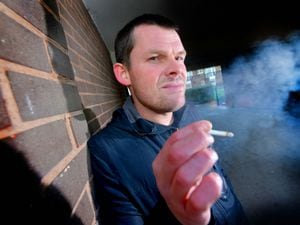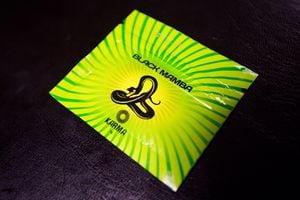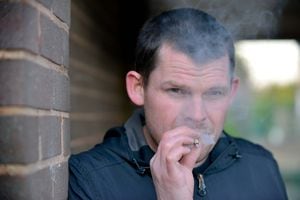'Spice turns you into a zombie': Battling an addiction with synthetic cannabis
Users of synthetic cannabis, or spice, have spoken on their daily lives and how the drugs have effected them.

It has been called the zombie drug, spice, Black Mamba, K2 – in fact there are hundreds of names for synthetic cannabis.
Scenes of people passed out on benches and in towns have accompanied the spread of spice across the country.
WATCH: Former 'Zombie drug' user recounts addiction
“I’ve wanted to kill myself on it,” says 32-year-old Darren Marshall from Telford, describing his past experience as a user of the drug.
“I’ve got to the lowest part of my life on it and it’s not a place I’d want to see anyone.”
“You can get if from shops, easy,” he adds, when asked about how he got hold of spice.
“They sell it under the counter. If you know them a bit you can pull them to one side and say ‘have you got any?’. They wouldn’t do it while people are in the shop. You can get it straight away. But if I saw someone on the street they would sell it me as well. They would bag it up and sell it.”

Originally from Wakefield, Darren came from a broken home and was bullied at school. His mother was an alcoholic and he started drinking aged 14.
Darren initially felt that his drinking gave him confidence, but it proved to be a gateway into pills such as ecstasy as well as cannabis.
And it plunged him into a depression. At one point Darren tried to commit suicide. At this point he wanted to change his life.
He kicked the pills and alcohol joining the A Better Tomorrow addiction rehabilitation program in Telford.
He was clean for a number of years, but turned back to the drink again and met a partner with whom he smoked cannabis.
“I was living in a bedsit.,” he says. “I started drinking every day again and got back to my old life. I was doing weed everyday as well.
“But weed wasn’t touching the sides with me, I wanted something a bit stronger. I was doing cannabis every day and it became the norm, I wasn’t really getting stoned off it.
“A mate gave us a bit of mamba. I thought ‘I love this stuff, it’s brilliant’. It’s stronger than weed. At the time I was skint, I didn’t have any money and I said I’d have some of it.”

Darren says he would spend about £10 for about a gram which would last him a day.
“I liked it and started getting it more and more. I stopped buying weed then and started smoking that because it was giving me a quicker and better high than weed,” he said.
“All you need from mamba is a few drags and you are feeling it. Wasted. It doesn’t smell like weed, it’s different.
“It starts turning you into a zombie and you don’t know what you’re doing on it. I’ve been on the roadside and I could have been robbed, mugged or anything. I don’t know where I am or what I’m doing.
“People smoke it anywhere. On a bench, wherever, it doesn’t matter. People would just walk away when they saw me. When I was laying on the pavement once and someone did help me. But some people were laughing, videoing.”

Darren says the spice gave him the escape he had been seeking in other drugs and alcohol. But it started to change his personality too.
“It did chill me out, but it also made me paranoid, shout and rage. That’s not me,” he says. “When I stopped taking it for a few days I would start to get pains in my side, vomiting and sweats in the night.
“It depends how much you have and if you have anything with it. You can have mood swings. It also depends what mindset you’re in when you do it.”
At the height of his spice addiction Darren says he didn’t care what was in the synthetic drug itself.
“You don’t know what it is, you don’t know what’s in it. On the packet it says not for human consumption,” he says.
“I didn’t care what was in it. I just took it. I didn’t even read the back of the packets when I did it, I wasn’t really that interested.”
After realising he had a problem with the spice and alcohol Darren managed to get clean again and rejoined A Better Tomorrow (ABT), where he remains. He has been clean for several months.
“I didn’t want to do what I was doing any more,” he says. “I decided to go back to ABT and give it another try. It’s going well. One day at a time.
“It’s about admitting you have a problem with it. It took me a long time to admit I had a problem. It’s hard to do that.”
Spice was made a Class B in 2017 and last year the Home Office asked the Advisory Council on the Misuse of Drugs to “refresh” its assessment of the drugs, potentially opening the door to their reclassification.
Sunny Dhadley is the programme lead at Wolverhampton’s Service User Involvement Team and he says that in Wolverhampton spice has receded from view, with crack cocaine and heroin becoming more readily available again.
“It is a major problem for vulnerable people in all communities,” he said. “What the criminalisation did not affect was the damage that taking these dangerous drugs does.

“From my own personal experience it is the homeless and people just out of prison that are taking synthetic cannabis.
“It pushes people who are already vulnerable further away from the support services they need.
“Walking through Wolverhampton city centre a few years ago you would have seen people visibly under the influence of synthetic cannabis, whereas nowadays people have been pushed out to other parts of the city. But just because you can’t see it it doesn’t mean the problem has gone away at all.
“On one hand the local authority has done a great job in tackling the homeless problem but for every one person you move off the street there is another two who are on the verge of becoming homeless.
“I have heard people say that the war on drugs has failed and has become a war on people who use drugs, which does not help turning these peoples’ lives around.”
Mr Dhadley added: “I am not aware of anywhere you can get it under the counter. In my experience the drug is mainly dealt by street dealers.”
Superintendent Tom Harding from West Mercia Police was keen to find out more about the sale of Spice.
“We know there may be concerns from a public health perspective around the use of substances such as spice and black mamba but from a police perspective we aren’t getting called to incidents regarding people’s safety in relation to this,” he said.
“We’re not seeing any violent crimes linked to the use or calls to crimes or anti-social behaviour often associated with substance misuse where spice or black mamba is a particular concern.
“Obviously though if anyone does have any information that may give a different picture or give us information about where this is being sold we want to hear from them.”
Information can be reported to West Mercia Police on 101 or anonymously via the independent charity Crimestoppers on 0800 555 111.
Shocking sights of Spice in prison
“I only smoked Mamba twice, I didn’t carry on with it because of the paranoia – it’s ruthless. It made me paranoid and I shut myself off.”
Melissa Harvey-Trustam, 28, saw at close quarters the devastating effect of spice on people during her time in prison.

She had become addicted to taking hard Class A drugs from the age of 15, and ended up spending time in prison in 2015 as part of a police sting to tackle the drug problem in the Telford.
It was there that she witnessed the destructive impact of the synthetic cannabis-based drug at close quarters – and the psychological impact far outweighed the physical effect.
“One of the biggest issues with it in prison is self harm,” she said. “There were a lot of suicides when I was in prison.
“In each suicide while I was in prison Mamba was involved.
“There were some horrific cases of hallucination.
“There was one girl who was smoking Mamba and she was hallucinating there were bugs underneath her skin and she actually bit into her arm and bled to death in her cell.
“It seems really dramatic, but it’s a psychoactive substance and is the worst drug I’ve seen in prison.
“There’s more Mamba in prison than anything else. There are ounces and ounces of it.
“The worst is people going over on it. Their eyes are open, but they are unconscious and they are falling all over the place.
“Everyone around them is just laughing, and recording it on their phones and putting it online.”

She says that spice would find its way into prison on after chemicals were sprayed onto paper which was the sent to inmates through the post – a means of transporting drugs that the Government has since launched mesaures to tackle.
“You then cut the paper up and put it in a cigarette,” she said.
Melissa now works in helping addicts at Telford After Care Team in Wellington, and says that there is not enough out there to help people who have become addicted to spice.
She says that one man she has been helping stay clean from Mamba is now incontinent and is forced to wear nappies.
“I do think there needs to be proper pathways,” said Melissa. “We have a pathway for a heroin addict, crack addict, cannabis addict, but there isn’t actually enough research been done around Spice and Mamba to have that.”
Mark Fairhurst, the national chair of the Prisoner Officers Association, the union which represents prison workers, said more needs to be done to tackle the issue behind bars.
“Spice is still there, it is still a problem,” he said.
“We need more robust measures in place.
“We need more officers at the gates to search people coming in, we need more staff to search cells when intelligence is passed on and we need more dog patrols to search perimeters of prisons.
“It comes down to a severe lack of funding in the prison service in the last 10 years.”
Just last week prisons were issued with specialist scanning equipment and detailed instructions on handling incoming mail following a surge in attempts to post drug-laced paper and other contraband to inmates.
Prisons Minister Rory Stewart said scanners which can detect invisible traces of drugs soaked into clothing and paper have been installed at 10 of the most challenging jails in the country.
He said drugs in prison have been a “game-changer”, driving self-harm and extreme violence, adding: “As the methods used to smuggle drugs into prisons continue to evolve, our response to that threat becomes ever more agile and vigilant.”
Peter Dawson, director of the Prison Reform Trust, suggested a straightforward way to reduce the problem would be to give prisoners “controlled access” to electronic communications, adding: “You can’t spray Spice on to an email.”
How mutant drug has changed
A chemistry professor has spoken out about the dangers of spice and warning against its devastating impacts.
Dr Simon Cotton is a senior lecturer in chemistry at the University of Birmingham and has been looking at the drug and its impacts on people.
“This stuff called spice is not just one substance,” he says. “There are dozens if not hundreds of psychotic substances.
“People using these drugs need to be aware that it is not like getting a medicine from your local chemist’s shop which has been developed by professionals, rigorously tested in the laboratory, producing the same effect in your body every time.
“What they are being offered can lead to a whole host of differing health issues, including intoxication, seizures, psychotic episodes, heart and kidney problems, and also death.”
The origins of the chemicals used to make spice date back to the mid-90s, when American chemist John Huffman was studying the impact of cannabis on the brain.
The production of synthetic compounds involved in the experiment led to the creation of a new compound, called JWH-018.
Fast forward over two decades and most spice sold on the streets doesn’t even contain that compound – instead, it contains variations of it, which are both untested and unreliable.
“It consists of dry plant material with synthetic chemicals sprayed on it,” he says.
“It may look like marijuana, but it is very different. Many of these synthetic chemicals are known as cannabinoids, not because they are grown in the same way as cannabis, but because – like molecules found in the cannabis plant – they act on what are called cannabinoid receptors in cells, which alter the way in which the brain’s neurotransmitter ‘messenger molecules’ are released.”
The differences in the synthetic drug make it unpredictable.





